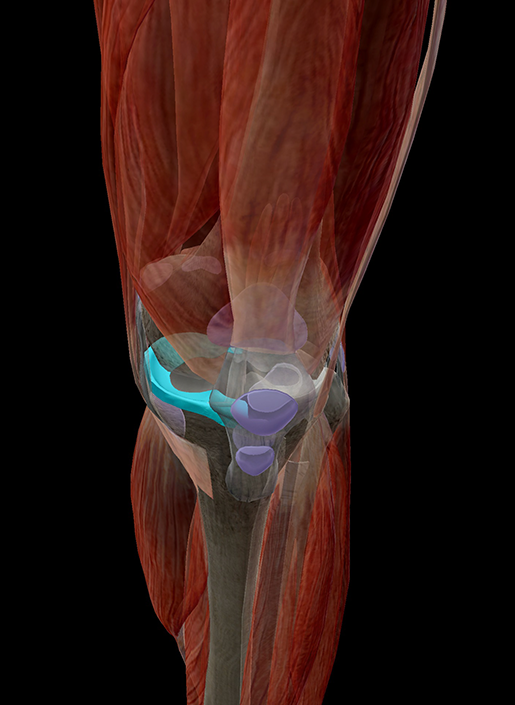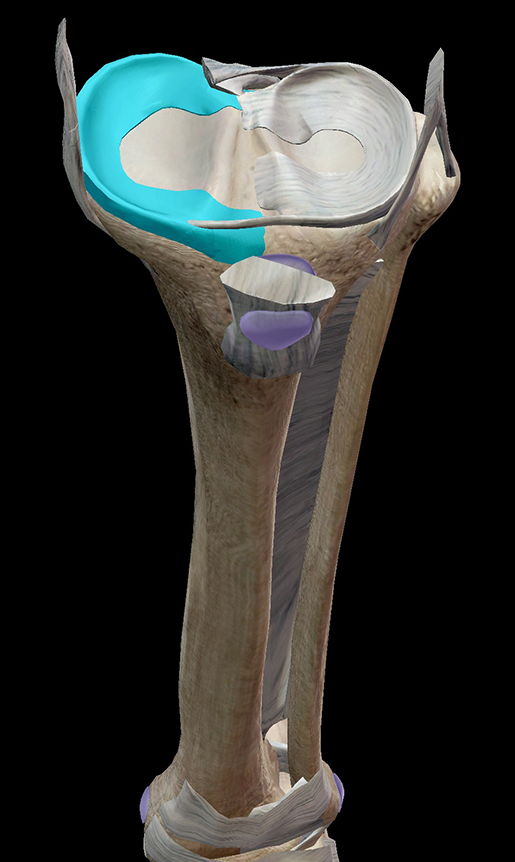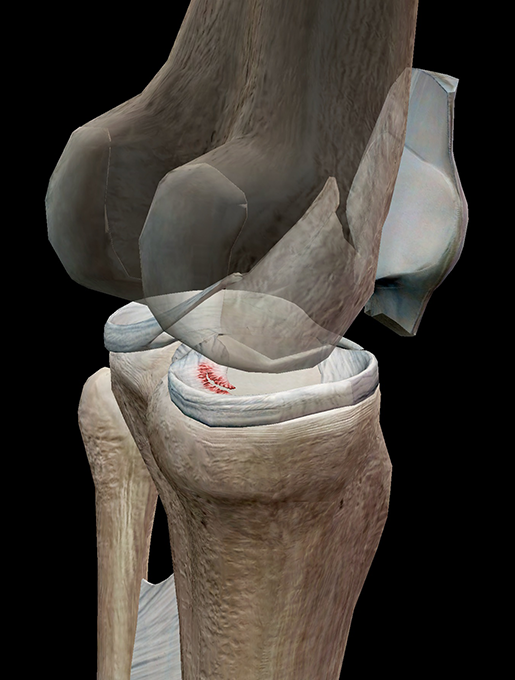Do The Twist: A Look at a Torn Meniscus
Posted on 5/13/16 by Courtney Smith
I’m sort of glad I never played a lot of sports as a kid, mostly because I don’t have enough fingers to count all the friends I had who hobbled around on crutches or wore arm casts because of their sports injuries. The weirdest one was when my friend Ashley tore her meniscus. She came crutching into homeroom with her knee in a brace and gladly demonstrated what happened when she put any weight on it: her knee immediately buckled, nearly sending her to the floor. I vaguely remember there being a smattering of grudgingly impressed applause.
A meniscus tear is one of the most common knee injuries, particularly for those who play sports or do things that involve a lot of sudden stops and turns. Ashley played tennis, so I suppose it was only a matter of time before something tore.

The medial meniscus in context. Image from Muscle Premium.
We’re going to take a look at the meniscus, how and why it can be injured, and what can be done to treat and prevent injury.
The Meniscus: Fibrocartilage or Ticking Time Bomb?
Your knees bear the brunt of a lot of things, whether you realize it or not. Think of all you use your knees for: walking, running, using your foot to scratch an itch on your leg, helping you lift something heavy … even just simply bearing your own body weight. Your knees don’t handle all of this alone; there are a bunch of ligaments and fibrocartilage that help dissipate pressure and reduce friction.
The meniscus is one of these fibrocartilage heroes. Flat and curved, almost like a pad, the meniscus covers each tibial condyle. The medial section of the meniscus attaches to the anterior intercondyloid fossa of the tibia, while the lateral covers a large part of the auricular surface—it’s twisted on itself so that its free margin rests on somewhat of a sloping shelf of the front of the lateral process of the intercondyloid eminence. Which is a bit of a mouthful. Basically, it’s a hat for the tibia, as you can see here:

Image from Muscle Premium.
Do the Twist: A Torn Meniscus
Like I said above, tearing the meniscus is relatively common. It’s not just sports that can cause it to tear, either. Sometimes it’s just plain old age and degeneration—we’re not perfect machines, after all. Our parts are subjected to the same wear and tear as anything.
The most common cause of meniscal tears is due to twisting while loading the knee, such as during a tennis match or other sport. If the meniscus has weakened and grown thin due to old age, sometimes even just standing up can cause it to tear!
Symptoms of a torn meniscus include pain, swelling, catching or locking of the knee (because there’s cartilage flapping around), or like what Ashley had experienced in that her knee “gave way.”
Meniscal tears are categorized by type and location. Vertical tears are along the longitudinal axis, while horizontal tears are along the transverse axis. A common location for a meniscal tear is the posterior horn, pictured here:

Image from Muscle Premium.
Up and Running: Diagnosis and Treatment for a Torn Meniscus
Despite the symptoms listed above, there are a few ways to know for sure if the meniscus has been torn. One way is to have an ultrasound, which a doctor will use to check out your knee while it’s in motion. If cartilage is flapping around in there and getting caught in the moving parts of the knee, the ultrasound will be able to show that. Another is to have a magnetic resonance image, or MRI, which uses radio waves and a magnetic field to produce surprisingly detailed images of soft and hard tissue—even a hard place to visualize like the inside of the knee.
If an ultrasound or MRI can’t produce a concrete result, an arthroscopy may be needed. In an arthroscopy, a small incision is made near the knee and an arthroscope (a camera and light source) is inserted into it to take a look around. The camera will produce an actual real-time image of what’s going on within the knee.
Depending on the severity of the tear, your doctor will prescribe one of several treatments.
If the tear isn’t too awful, you’ll most likely be told to rest your knee (you may even get crutches out of the deal) and to apply ice to reduce any swelling. Over-the-counter painkillers, like ibuprofen, can help both with pain and inflammation.
Physical therapy can be helpful in strengthening the muscles of the knee and the leg for better stability. Surgery can be successful in severe cases, either in repairing the meniscus or trimming it altogether.
So, be kind to your knees. Treat them like you would someone on a date: have fun with them, but don’t go too fast or else you risk ruining the night.
Be sure to subscribe to the Visible Body Blog for more anatomy awesomeness!
Are you a professor (or know someone who is)? We have awesome visuals and resources for your anatomy and physiology course! Learn more here.
Related Posts:
- Learn Muscle Anatomy: Muscles of Mastication
- Learn Muscle Anatomy: Knee Joint Group
- Learn Muscle Anatomy: Bursae
Additional Sources:
"Torn Meniscus." Mayo Clinic. Tests and Diagnosis. Web. 13 May 2016.




